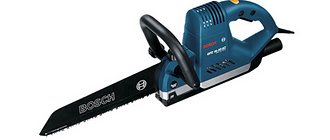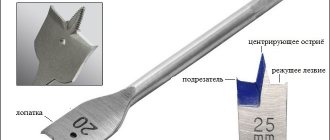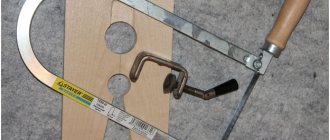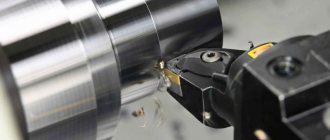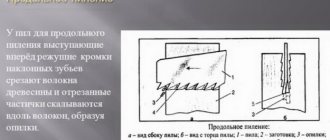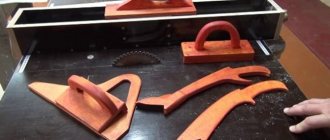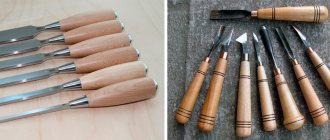Purpose of files
A file is a universal-purpose hand tool capable of cutting off a thin layer from the surface of the material being processed with one forward movement. It can be used to solve many different problems:
- Clean parts and workpieces from rust and other types of corrosion.
- Remove a layer of dirt or paint.
- Turn the part until the required size is obtained.
- Sharpen other tools used in everyday work.
- Clean electrical contacts in electrical equipment systems.
- Grind and polish the surface of metal and other materials.
Special varieties
A type of file (usually a diamond) is a nail file, which is part of manicure sets.
Main article: Thread file
Jammed or otherwise damaged threads can be repaired using a thread file. Such files, as a rule, have several different working edges designed for cutting threads of various pitches.
Main article: Musat
To straighten knives, musat is used - a round, sometimes oval, rod with a notch, ribs along its length.
Types of files
Modern schoolchildren, finding themselves in tool shops on excursions, often look with a grin at the tools used by toolmakers. There may be sophisticated machines nearby that can cut off thick layers of metal within a few seconds.
And mechanics process the part using hand tools with handles, moving them over the workpieces, achieving the desired size or type of part. Often, to clarify some features, the results of work are viewed through magnifying glasses.
However, sometimes the fine finishing of a product cannot be entrusted to a machine. Only with the help of a file or its younger brother, the needle file, can the required parameters be achieved. These tools are used to remove a layer of metal.
Most often, a strong steel strip has a notch on it. These are low teeth located in a certain sequence (a special notch is applied). A special standard (GOST 1465-80) approves the rules for the location of teeth and their shape.
For manufacturing, carbon steels (U9...U11) or special iron alloys with alloying elements are used. The files undergo heat treatment, as a result of which the surface hardness reaches up to 54...60 HRC (Rockwell hardness).
For ease of use, the end has a triangular or cylindrical shank. A handle is placed on the shank. It is made from different materials (wood, plexiglass, metal). Professionals prefer to use wooden handles made of birch or walnut.
Important! To prevent the handle from splitting when the shank is driven in, a metal ring is installed at the end.
Rasp and its difference from a file
Despite its rough appearance, the rasp is intended exclusively for working on soft metals, as well as wood, plastic, rubber and leather. A rasp differs from a file not only in its larger size, but also in the type of notch - point. It is through the use of a pinpoint cut with high roughness that it is possible to achieve high efficiency in processing materials.
These tools come in different shapes (flat, round and semicircular) and sizes, and they are often used not for grinding, but for roughing materials. For their manufacture, steel grades U8, U10 and U7 are used. Despite the great similarity with a file, a rasp differs from it not only in external features, but also in purpose.
Tool steels for making files
While studying the properties of steel, we noticed that at a certain carbon content it becomes possible to obtain high hardness using special heat treatment. The low carbon content does not allow hardening, which increases the strength properties of the metal.
Only at a concentration of 0.8% and above do the properties of the Fe-FeC₃ alloy change (the properties are studied in a special course in metal technology, called “Materials Science”). Annealed steel is quite ductile and can be processed on metal-cutting machines. There is a condition in which high plasticity is noted. It is called austenite. Achieved at a temperature of 727 ⁰C and above.
Only hypereutectoid steels can be quenched and tempered. If there are no other additives, then they are usually designated as U8...U13. The letter “U” characterizes carbon steel, and the number indicates the carbon content in hundredths of a percent.
Attention! To carry out hardening, it is necessary to heat the steel part to the austenite temperature and above. It can be easily identified using a magnet. When the desired value is reached, the magnetic properties completely disappear when heated.
Some people believe that heating to the appropriate temperature is enough. When heated, the thermal conductivity of the metal decreases sharply. Within one minute, parts weighing about 1 kg are heated to a depth of 0.10...0.13 mm.
Important! To harden the surface to a depth of 1.5...2.5 mm, you will need to hold it at the desired temperature for at least 15...20 minutes. Less deep hardening may result in the measuring cone on the Rockwell instrument falling through a thin layer of hardened metal. The result will be disappointing.
Hardening is carried out in water, air and mineral oil. A high cooling rate promotes deeper hardening of the metal. When making cutting tools, they are hardened in oil. Steel cooling occurs at a rate of 400…450 ⁰/sec.
After hardening, the parts acquire a certain fragility. Therefore, to relieve internal stresses, low tempering is performed. It occurs at a temperature of 180...250 ⁰С. The part is placed in muffle furnaces heated to a given temperature. Keep in them for at least 30...40 minutes. Then they allow it to cool slowly.
In practice, heat treatment of file metal occurs in the following sequence:
- The workpiece is heated to a temperature of 900…920 ⁰С (the higher value is explained by the fact that less time is required for internal heating of the metal).
- Maintain in a heated state for 15...20 minutes.
- It is hardened in mineral oil (it is allowed to use waste from internal combustion engines).
- Hardness testing is carried out, and with proper heating and cooling, hardened trostite (HRC 54...58) is obtained.
- The workpiece is placed in a muffle furnace at a temperature of 200…210 ⁰С.
- Leave for 30...40 minutes and take out.
- It cools down in air (temperature 18...22 ⁰С) on its own.
- The hardness is checked; for tempered trostite (the state of hardened and tempered metal), the hardness increases by 2...4 units.
To increase the strength and hardness of steels, alloying elements are added during welding. They make it possible to improve performance characteristics and obtain metal with desired properties.
File shapes
Types of files for metal have been developed over the past two hundred and fifty years. Dimensions and parameters were determined depending on the tasks that needed to be performed. Therefore, the shape of the teeth was also adjusted.
Initially, craftsmen were required to process cast iron, as well as products made of brass and bronze. The castings had a gating system and a burr. They were sawed off, and then the surface was polished. Files with different tooth sizes were used. For rough processing, a tool was used that was capable of removing up to 0.5...1.0 mm of a layer in one movement.
In the future, modern craftsmen have sets of hand-held cutting tools, which they use to bring parts to the required parameters. At manufacturing enterprises there is a category of workers (mechanics). One of the main tools is files.
Classification by section shape
The form determined the name and purpose of the files, and the main classification was created on it. Depending on the profile of the surface being processed, the cross-section of the tool is selected. Manufacturers of files suggest using special hand tools with the following sections:
- Flat – files of this shape are suitable for processing flat and rounded (protruding) surfaces. This is the most common cross-section for such a tool.
- Square files are used for processing rectangular and square holes. They grind rectangular grooves on the surface.
- Round - they are used to process internal cavities and holes, remove sagging from welds and flash from castings. The desired configuration is achieved by finishing elliptical surfaces inside the part.
- Triangular - in cross-section they represent a regular triangle with an angle of inclination of the surfaces of 60 ⁰ to each other. Most often, such a tool is used to sharpen the teeth of another tool, for example, a hacksaw for sawing wood.
- Special - at some enterprises, specially shaped files are made in tool shops. For example, in the manufacture of air-cooled two-stroke internal combustion engines, the inlet ports must be modified. The blanks are produced by casting, but finishing is done manually (cheaper than using a specialized machine).
- Oval or semi-cylindrical files are used for processing cylindrical or conical cavities.
Depending on the size of the parts being processed, hand tools are made in different lengths. When steam locomotives were used, each crew of drivers had a file 720 mm long. Used to clean soot and other contaminants from the surface of steam boiler pipes.
Modern files are rarely made longer than 500 mm (the size is determined by the length of the working part where the teeth are). For small jobs, for example, watchmakers use needle files with a working length of about 50 mm.
There is an accepted rule: the larger the tooth, the longer the working part. The explanation is quite simple. The work is performed in a forward motion. By moving the working part further, we achieve deeper removal of the layer when grinding.
Large teeth leave deep marks on the treated surface. To achieve a better surface, allowance is left to obtain a high-quality surface. It is obtained by processing using files with smaller teeth.
Using velvet files, you get a shiny surface with a minimum amount of scratches. Subsequent polishing is done using other tools. In practice, processing is carried out in several stages (at least two). The first is processing with a rough tool, the second is finishing surfaces.
How to choose a file – a good choice!
When choosing a file, first of all, conduct a visual inspection to identify cracks or other defects. Of course, identifying cracks by eye is not so easy. But the sound will help you identify them with one hundred percent probability! To do this, lightly tap the working part on something hard and listen to the resulting sound - if it is clear, then there really are no cracks. But if rattling is heard in the sound, then such an instrument can be thrown away immediately.
During hardening, the tool may bend - this is considered a manufacturing defect, so if you come across such a tool, you can safely exchange it for a straight one. Pay attention to the notches - the teeth should be sharp, even, without gaps, directed towards the nose of the file. It is not allowed that there are visible traces of rust or any dirt on the surface upon purchase.
Features of the use of manual turning tools
There is a very conditional division according to purpose. The main categories are identified.
- Bench files are the most common files. They are used in any industrial enterprise. It is not difficult to find such a tool in home workshops and personal households.
- Needles are used for fine work. The main users are jewelers and metalworkers. Without small tools it is difficult to handle hard-to-reach places. For example, Mikhail Timofeevich Kalashnikov, already a famous designer of automatic weapons, modified individual parts independently using a set of needle files.
- Sharpening files (mostly triangular and diamond-shaped) are used to sharpen teeth on hacksaws, saw chains and other places where cutting edges need to be restored to the required sharpness.
- Rasps are a special class of tools used for processing wood and other non-metallic materials. They are distinguished by the presence of teeth of a special point shape. Sometimes rasps are called bastard files, although this is not entirely true.
Types of notches on the surface of the tool
Based on the nature of the notches, it is customary to speak of a single or double design.
Single execution is more common with rough instruments. Here the tooth has a long cutting edge. Its length corresponds to the width of the file. To make it easier to penetrate into the thickness of the metal being processed, the notch is made inclined at an angle of 25⁰. The result is cutting with some displacement. It makes it easier to penetrate deeper into the part. The effort is slightly reduced.
The double design of the notches is made at an angle to each other. The second cut is made at an angle of 45⁰. Now the cutting teeth are limited in length. Where the lines intersect, places where chips break are formed. Consequently, such files require less physical effort during operation (no need to waste effort on twisting long shavings).
Set of files - different sizes, different cuts
The manufacturers of these tools do not adhere to any size limits - the product can be either 50 mm long or 500 mm long. When determining the length, only the part that has notches is taken into account; the file handle is not included in these calculations. According to the notches, instruments are divided into 4 categories:
- Products with a single notch, which is applied at an angle of 45° or 70°. Thanks to this notch, it is possible to remove wide chips. After processing, the material will be slightly rough;
- A cross or double notch is a combination of a single and an auxiliary, less deep one, which is made at an angle to the main one. At the intersection points of the notches, the resulting chips are broken during the filing process;
- The “Oberg” notch is the same combination with an auxiliary notch, only much rarer. This is an intermediate option between single and double types;
- A point or rasp cut is typical for files that are used in processing non-metallic materials such as leather, rubber, or for very soft metals;
- Arc cut is found on tools designed for processing soft metals. It is characterized by large cavities between the teeth, and its arched shape ensures high productivity and quality of processing.
Numbering of notches on tools
Table for determining the notch number in relation to different section shapes
The size of the tooth on the surface depends on the density of the notches. The more there are, the smaller the teeth.
The classification of notches according to digital values from 0 to 5 is accepted. The largest teeth can remove up to 0.8...1.1 mm of metal. It is customary to assign the number “0” or “1” to such an instrument. Such an instrument was called “drachevy”.
Files that cut metal to a depth of 0.02...0.04 to 0.08...0.10 mm in one pass are numbered “2” or “3”. Such files are called “personal”.
If the tool removes 0.010...0.015 mm, then it is assigned the number “4” or “5”. They are called "velvet". When working with them, the highest processing quality and accuracy are obtained.
Typically, the notch is applied using the rolling method. The workpiece heated to the austenitic state is fed to the forming machine. The roller system rolls channels on the working surface of the tool.
The milling method is used to make personal and velvet files. The treatment is performed on workpieces before hardening.
Classification of devices
Like any other tool, this class of metalworking tools is represented by several types of files. Their purpose depends on the characteristics. A detailed description of each of them helps to understand whether they belong to a particular species.
Notch size
The type of material processing depends on the dimensions of the profile cutting of the tool surface. This characteristic means the number of teeth distributed per linear centimeter of the product:
If there are from 5 to 13 teeth applied to a segment, then such a tool is called a drachyov and bears the first number.- With a number of cuts from 13 to 25, the file will be personal with the second number.
- Devices with the smallest notches (25-80 teeth) are numbered from 3 to 6 and are called velvet.
Tooth sizes
The dimensions depend on the number of notches. The following classification is accepted:
- Files numbers 0 and 1 have 10…13 teeth per centimeter of length.
- Numbers 2 and 3 are characterized by the presence of 14...25 depressions per centimeter of length.
- Velvet files can have from 30 to 80 cavities per 1 cm of working surface.
A tall tooth gets clogged less often. Small teeth when processing soft metals can become clogged quite quickly. Therefore, metal brushes are used for cleaning; they remove metal residues from the cavities.
DIY file handles
Real craftsmen equip their existing tools with handles made by themselves. With the advent of plastics, there was a wider choice of materials for homemade products.
If you have a lathe, then the handle can be turned from hardwood: walnut, birch, ash. There are quite a lot of drawings on the Internet, using which a suitable handle is made.
Some craftsmen use epoxy resin to make unusual handles.
- First, possible porous materials that can be impregnated with epoxy resin are selected. Most often, fabrics of different colors are used. Micarta is created - a multi-layer fabric impregnated with epoxy.
- They are placed in the desired sequence.
- The epoxy resin is diluted according to the attached recipe.
- Wet each layer.
- Lay in the chosen sequence and place under a press.
- After polymerization is completed, a new material is formed - micarta.
- A file handle is made from micarta.
Video: Cuban files.

